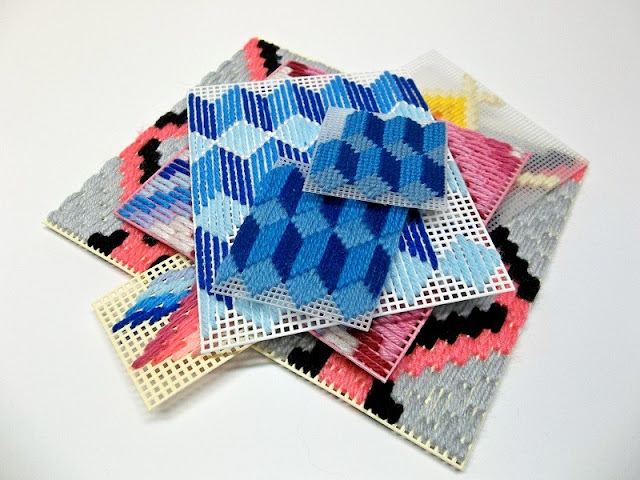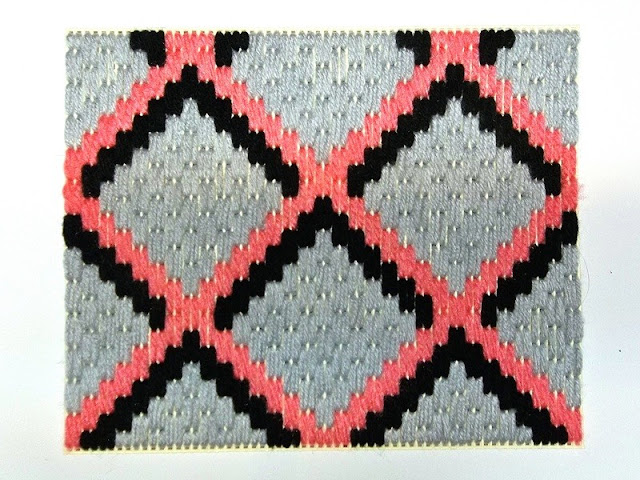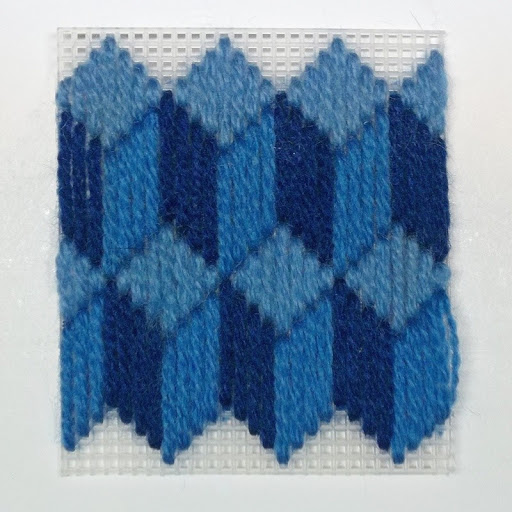 |
| Optical illusion needlepoint samples |
We're going to explores some patterns that fool the eye into seeing things that are not really there. These include 3-dimensional objects that appear to extend out from the canvas, “hollow” spaces in the canvas showing depth, textured surfaces, and interwoven areas where sections appear to pass over and under each other. Some optical illusions can be traced back to Early American quilt blocks. One of these, called “Tumbling Blocks”, was the inspiration for our first project. You will need either plastic or fiber canvas, at least one tapestry needle, 3 shades of one color of yarn, and scissors. I did the sample on #7 plastic canvas with knitting yarn to make the stitches easily visible.
 |
| Reversible block illusion, the basis for "Tumbling Blocks" |
Begin in the upper left-hand corner of your canvas (or the upper right-hand corner if you are left-handed) with the lightest shade of yarn. Count down to he 4th square of mesh. Bring your needle up through this square from the back. Pull the yan through, holding some against the back of the canvas so you can secure it by stitching over it. Stitch down over 2 threads of mesh (or 2 bars of plastic canvas). Bring your needle up through the next higher square of mesh in the next row and stitch down over 4 threads. Repeat, stitching over 6 threads in the next row and 8 threads in the 4th row. Then repeat the stitches over 6, 4, and 2 threads. You have made a little diamond like those in the top row of the sample below. Skip one row of squares of mesh and begin the next diamond in the following row. Make a row of at least 4 complete diamonds. Secure your yarn on the back of the canvas.
Thread your needle with the darkest shade of yarn. Beginning in the empty square between the diamonds, stitch down over 9 threads. Make 3 more such stitches, starting in the same square of mesh where a diamond stitch ended, each over 9 threads. Move over to the next diamond and repeat. Continue until you have made one side of the block below each diamond as in the sample. Work another row of light-colored diamonds. Put in the dark sides of the blocks. Now thread your needle with the medium shade of yarn. Fill in the remaining side of each block with four stitches down over 9 threads each. I worked an additional row of blocks on the sample, showing the top diamonds back- stitched in white. This is optional.

 This post by Annake's Garden is licensed under a Creative Commons Attribution-NonCommercial-ShareAlike 3.0 Unported License.
This post by Annake's Garden is licensed under a Creative Commons Attribution-NonCommercial-ShareAlike 3.0 Unported License.
The other “tumbling block” samples were done on #10 canvas with tapestry yarn. The blocks are much more distinct on the smaller mesh. The separations are so clear that back-stitching is not needed, but you may do it if you like the effect. (I recommend that — once you have mastered one of these patterns — you repeat it on #14 canvas for maximum effect.) You can now see that your eye moves back and forth from blocks that appear to be pointing upward and acting like stepping stones to blocks that appear to be pointing downward and coming out of the canvas. The illusion is complete.
We haven't forgotten those of you who prefer tent stitching. This pattern adapts easily to being worked in continental stitch, as you can see in this sample. You will have to make two small adjustments in the directions, however, to make it work. Your top diamond is now made with this pattern of stitches:
1
123
12345
1234567
12345
123
1
The dark side of the block is unchanged, with 4 rows of 9 stitches vertically. But the first vertical row of the medium color has only 8 stitches, followed by 3 rows of 9 stitches each. That's it.
The second project uses the illusion of depth. It appears that you are looking down at a surface that is farther away than the surface of the canvas. This is quite a large sample, so we have shown it at a distance to illustrate the effect. You will need a bright yarn, a dark yarn, and a light yarn. (By now you have probably realized how nice it is to have several tapestry needles for your work.) If you are working on the same piece of canvas, turn it so that you start in the same corner as for the first project. Count down to the 19th square of mesh. Bring your needle up in that square with the bright yarn and stitch up over 4 threads. Make a second stitch just like this in the next row. We have done ascending and descending stitches before (See the post for March 21, 2014). Each stitch will cover 4 threads and each will be doubled. The step, either up or down, will be 2 threads. You are going to do a diagonal stepped line of 8 pairs of stitches. This should bring you to the top of your canvas. Then you are going to step down diagonally for 7 pairs of stitches, bringing you to the level where you started. Turn your canvas 180 degrees and complete the diamond in the same way. Using the picture as a guide, make several diamonds, both horizontally and vertically. Notice that each pair of diamonds shares a pair of stitches.
 |
| Diamond-shaped boxes |
With your dark yarn, put in a row of stitches under the top of each of the bright diamonds. The stitches are the same size, as are the steps. This time you step up 7 pairs and down 6. The rest of the diamond will be filled with the light yarn with the following rows: up 6, down5: up 5, down 4; up 4, down 3; up 3, down 2; up 2, down 1, finishing with a single pair of stitches. Complete several filled diamonds until the pattern emerges. Practice the pattern on a finer mesh if you can.
The more shaded rows you have inside the diamond, the deeper the “box” or “room” appears to be. I'm going to leave you with the start of one such pattern to see what you can do with it. This makes a striking allover pattern on a smaller-scale canvas. For a nice masculine look, use white for the lattice pattern, black for the small diamond shape, and deepening shades of gray for the “walls”. One of these days, I am going to use this technique on a honeycomb pattern; I'm working on it, but it isn't ready yet!
Remember that practice makes for perfection,
 |
| Twisted Ribbons - a sample from the next set of projects |




It's that time of the year when productivity plummets and "Cinderella" references hit an annual high. March Madness is upon us, so here's everything you need to know about the NCAA tournament. March Madness is Starts on March 13, 2022. Here is a complete guide to watch March Madness 2022 online from anywhere without cable. How to Watch March Madness 2022 Live from available at home.
ReplyDelete